Do you have a question about the Hitachi RAF-50NXA1 and is the answer not in the manual?
Key safety measures for installing the air conditioner, including grounding and proper piping.
Safety guidelines for moving or servicing the unit to prevent electric shock or fire.
Essential safety rules for operating the air conditioner to avoid hazards.
Explains the remote display elements like temperature, time, and indicator lights.
Covers essential buttons for controlling operation: Start/Stop, Temperature, Fan Speed, and Mode selection.
Details on setting timers (ON/OFF), sleep timer, and auto swing features.
Guidelines for proper handling, placement, and care of the remote controller.
How to set the unit to automatically select HEAT, COOL, or DEHUMIDIFY based on room temperature.
Using the START/STOP button to begin or end the air conditioner's cycle.
How to raise or lower the desired room temperature using the temperature buttons.
Instructions for selecting fan speed modes like AUTO, LOW, and SILENT.
How to select the HEAT mode using the FUNCTION selector on the remote.
Steps to set desired fan speed (AUTO, HI, MED, LOW, SILENT) and room temperature.
Using the START/STOP button to initiate or cease heating operation.
Explains the automatic defrosting process, its duration, and indicator lamp behavior.
How to set the unit to DEHUMIDIFY mode and select LOW/SILENT fan speed.
Using the START/STOP button to begin or end dehumidifying operation.
Explains target temperature, operation stops/restarts based on room temperature.
How to select the COOL mode using the FUNCTION selector on the remote.
Steps to set desired fan speed (AUTO, HI, MED, LOW, SILENT) and room temperature.
Using the START/STOP button to initiate or cease cooling operation.
How to choose the FAN mode for air circulation or drying the indoor unit.
Options for fan speed: HI, MED, LOW, SILENT, and AUTO.
Using the START/STOP button to activate or deactivate fan-only mode.
Details on how AUTO fan speed adjusts during heating and cooling operations.
Procedure to set the current time on the remote controller, essential for timer functions.
Instructions for setting OFF-TIMER, ON-TIMER, and ON/OFF-TIMER functions.
Procedure to cancel any previously set timer reservations.
How to program the unit to turn off after a set number of hours.
Using sleep timer for turn-off and ON-timer for early morning activation.
Procedure to cancel a previously set sleep timer.
Using the AUTO SWING button to control horizontal air deflector movement.
Manually adjusting the vertical air deflector for side-to-side air direction.
Warning about water condensation on deflector during cooling with downward tilt.
Steps to remove the cover, replace old batteries with new ones, and ensure correct polarity.
Important notes on mixing battery types and removing batteries for long-term storage.
Tips for economical and healthy operation through average room temperature settings.
Importance of ventilation and avoiding blockage of air intake/outlets for performance.
Advice on what cleaning agents to avoid for unit longevity.
Procedure for cleaning the air filter every two weeks to maintain efficiency.
Instructions for removing, washing, and reattaching the front panel.
Steps to dry the indoor unit and turn off the circuit breaker before extended storage.
Information on installing, using, and lifespan of optional air cleansing filters.
Explanation of heat pump system and factors affecting heating performance.
Factors influencing cooling/dehumidifying effectiveness, like room heat load.
Details on operation feedback, protective circuits, and fan speed effects.
Confirming timer settings, priority of sleep timer, and fan speed during sleep mode.
Checks for earth line connection and mounting frame integrity every half-year or yearly.
Checks for remote signal, operation, cooling/heating problems, and filter blockages.
Lists normal operational sounds and visual effects like blinking lamps or mist.
Identifies critical failure signs requiring immediate contact with the sales agent.
Key safety measures for installing the air conditioner, including grounding and proper piping.
Safety guidelines for moving or servicing the unit to prevent electric shock or fire.
Essential safety rules for operating the air conditioner to avoid hazards.
Explains the remote display elements like temperature, time, and indicator lights.
Covers essential buttons for controlling operation: Start/Stop, Temperature, Fan Speed, and Mode selection.
Details on setting timers (ON/OFF), sleep timer, and auto swing features.
Guidelines for proper handling, placement, and care of the remote controller.
How to set the unit to automatically select HEAT, COOL, or DEHUMIDIFY based on room temperature.
Using the START/STOP button to begin or end the air conditioner's cycle.
How to raise or lower the desired room temperature using the temperature buttons.
Instructions for selecting fan speed modes like AUTO, LOW, and SILENT.
How to select the HEAT mode using the FUNCTION selector on the remote.
Steps to set desired fan speed (AUTO, HI, MED, LOW, SILENT) and room temperature.
Using the START/STOP button to initiate or cease heating operation.
Explains the automatic defrosting process, its duration, and indicator lamp behavior.
How to set the unit to DEHUMIDIFY mode and select LOW/SILENT fan speed.
Using the START/STOP button to begin or end dehumidifying operation.
Explains target temperature, operation stops/restarts based on room temperature.
How to select the COOL mode using the FUNCTION selector on the remote.
Steps to set desired fan speed (AUTO, HI, MED, LOW, SILENT) and room temperature.
Using the START/STOP button to initiate or cease cooling operation.
How to choose the FAN mode for air circulation or drying the indoor unit.
Options for fan speed: HI, MED, LOW, SILENT, and AUTO.
Using the START/STOP button to activate or deactivate fan-only mode.
Details on how AUTO fan speed adjusts during heating and cooling operations.
Procedure to set the current time on the remote controller, essential for timer functions.
Instructions for setting OFF-TIMER, ON-TIMER, and ON/OFF-TIMER functions.
Procedure to cancel any previously set timer reservations.
How to program the unit to turn off after a set number of hours.
Using sleep timer for turn-off and ON-timer for early morning activation.
Procedure to cancel a previously set sleep timer.
Using the AUTO SWING button to control horizontal air deflector movement.
Manually adjusting the vertical air deflector for side-to-side air direction.
Warning about water condensation on deflector during cooling with downward tilt.
Steps to remove the cover, replace old batteries with new ones, and ensure correct polarity.
Important notes on mixing battery types and removing batteries for long-term storage.
Tips for economical and healthy operation through average room temperature settings.
Importance of ventilation and avoiding blockage of air intake/outlets for performance.
Advice on what cleaning agents to avoid for unit longevity.
Procedure for cleaning the air filter every two weeks to maintain efficiency.
Instructions for removing, washing, and reattaching the front panel.
Steps to dry the indoor unit and turn off the circuit breaker before extended storage.
Information on installing, using, and lifespan of optional air cleansing filters.
Explanation of heat pump system and factors affecting heating performance.
Factors influencing cooling/dehumidifying effectiveness, like room heat load.
Details on operation feedback, protective circuits, and fan speed effects.
Confirming timer settings, priority of sleep timer, and fan speed during sleep mode.
Checks for earth line connection and mounting frame integrity every half-year or yearly.
Checks for remote signal, operation, cooling/heating problems, and filter blockages.
Lists normal operational sounds and visual effects like blinking lamps or mist.
Identifies critical failure signs requiring immediate contact with the sales agent.
| Brand | Hitachi |
|---|---|
| Model | RAF-50NXA1 |
| Category | Air Conditioner |
| Language | English |

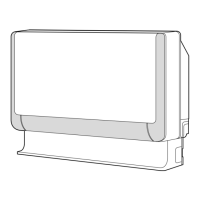


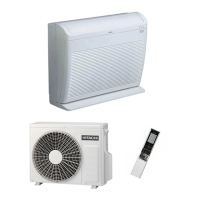


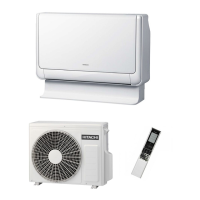
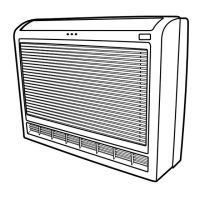
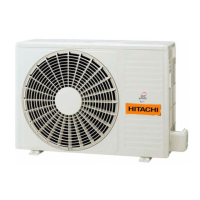
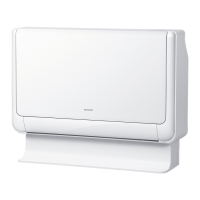

